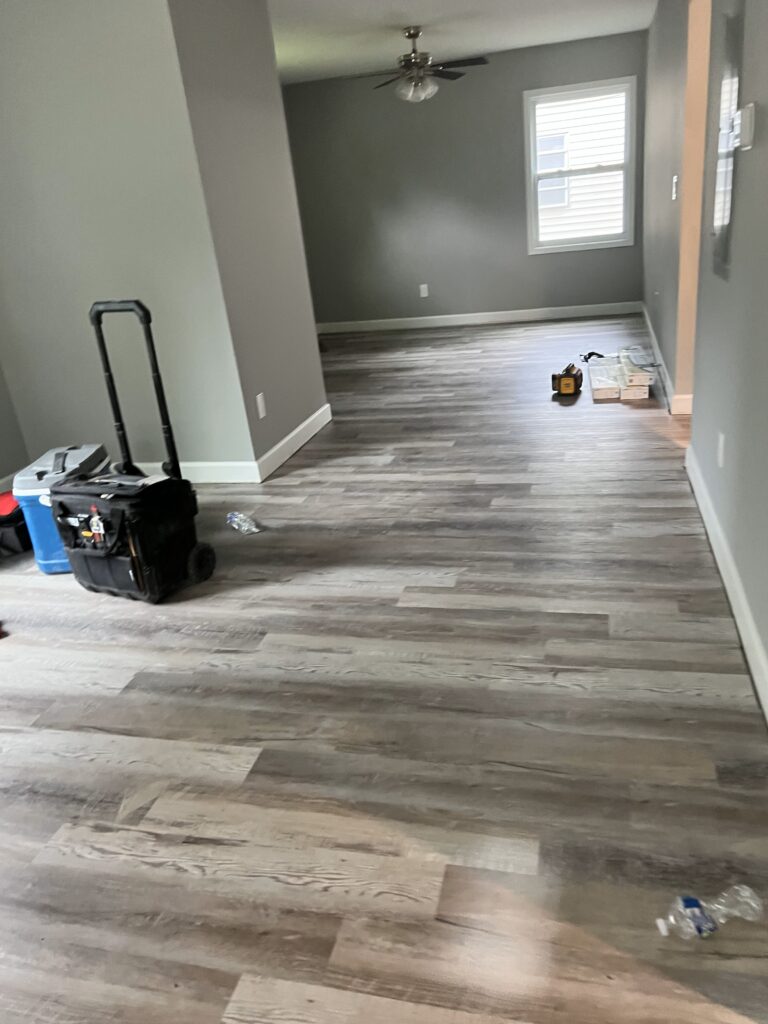Flooring installation is the process of laying down a new floor in a room or throughout an entire space. It can be done with various materials, depending on the desired style, function, and durability. The installation process involves preparing the subfloor, selecting the right flooring material, and properly installing it for long-lasting, secure results.
Type of Flooring:
- Vinyl: Available in sheets, tiles, or planks, vinyl flooring is water-resistant, durable, and easy to maintain. It comes in a variety of styles, including options that resemble wood or stone.
Steps for Flooring Installation:
- Preparation:
- Remove Old Flooring: If you’re replacing existing flooring, the old floor must be removed. This may involve tearing up carpet, tile, or removing nails and staples from hardwood.
- Check Subfloor: Ensure that the subfloor (the surface beneath the flooring) is clean, dry, level, and free of any damage. You may need to patch holes, remove debris, or level out any uneven areas.
- Acclimate Materials: If you’re installing wood, laminate, or engineered wood, it’s a good idea to let the planks acclimate to the room temperature for 48–72 hours before installation to avoid expansion or contraction after installation.
- Installing the Flooring:
- Vinyl:
- Peel-and-Stick or Click Lock: Vinyl flooring comes in peel-and-stick tiles or planks, and click-lock vinyl that snaps into place. Some options are self-adhesive, while others require glue or other adhesives.
- Vinyl:
- Finishing Touches:
- Trim and Baseboards: Once the floor is in place, install baseboards or trim to cover the expansion gap around the edges and give the room a polished, finished look.
- Cleaning: After installation, clean the floor to remove any dust, adhesive, or installation materials. For hardwood or laminate, use a dry mop or specific cleaner to avoid damage.
- Sealing: If you’re using porous materials like tile or natural stone, you may need to apply a sealer to protect the surface from stains and moisture.
Considerations for Flooring Installation:
- Subfloor Condition: The condition of the subfloor is crucial. If the subfloor is not level, it may cause the flooring to buckle or wear unevenly.
- Moisture Levels: Some floors, like wood, are sensitive to moisture and temperature changes, so it’s important to consider the climate of your area and moisture levels in the room (e.g., basements, bathrooms).
- Traffic and Durability: High-traffic areas need durable materials that can withstand wear, such as tile, hardwood, or commercial-grade vinyl. Consider the purpose of each room when choosing your flooring.
- Style and Color: Flooring plays a significant role in the overall aesthetic of a room. Think about the color scheme and design style of the space, as well as how the flooring will complement furniture and decor.
- Installation Complexity: While some types of flooring (like laminate and vinyl) are DIY-friendly, others (like hardwood and tile) may require professional installation, especially if specialized tools are needed for cutting or adjusting pieces.
Benefits of Professional Installation:
- Expertise: Professionals have the experience and tools to install flooring efficiently and properly, avoiding common mistakes.
- Time-Saving: Professional installers can complete the job faster than DIYers, reducing the disruption in your home.
- Quality: With professional installation, you’re more likely to get a high-quality finish, ensuring that your floor looks great and lasts for years.
Cost of Flooring Installation:
The cost of flooring installation can vary greatly depending on the material chosen, the complexity of the job, and the size of the area. On average:
- Vinyl: $1.50–$7 per square foot.
Conclusion:
Flooring installation is an important part of home renovation, whether you’re updating one room or an entire house. Choosing the right flooring material for your needs and ensuring it’s installed properly will provide lasting benefits in terms of aesthetics, comfort, and durability. If you’re unsure about the best option or installation process, consulting with a professional can help guide you through the decision-making process and ensure the job is done right.






